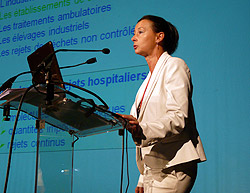Pollution of hospital waste with cytotoxic compounds
8 October 2009
S. Zini Agence Française de Sécurité Sanitaire de l’Environnement et du Travail (Afsset), Maisons-Alfort, France
AFSSET (The French Agency for Environmental and Occupational Health and Safety) is a public administrative authority working to ensure the health and safety of all professional environments.
Over the last few years AFSSET has taken a keen interest in the health risks posed by the discharge of medicines and other micropollutants in waste water, and particularly emissions of cytotoxic waste from hospitals. The potential risks attached to these waste products are not well understood, and detailed studies and research will be necessary to allow us to better understand the dangers, profile the levels of exposure and evaluate the concomitant risks for human health and the environment.

With this in mind, AFSSET has conducted a study aiming to assess the level of anti-cancer drug contamination in the waste water of hospitals [1] [2]. This study was carried out at two large hospitals specialising in anti-cancer treatments. The levels of five representative anti-cancer compounds, chosen on the basis of various selection criteria, were measured in the waste water emitted from the two hospitals: once before arrival at the water treatment facility and once again after treatment. The study lasted for three months, with over 200 samples tested. The results reveal that certain molecules are present in considerable quantities in the waste water leaving the hospitals, are only incompletely broken down at the treatment station, and are then released into the water cycle downstream.
This study highlights the diffuse pollution risk posed by the release of hospital medicines into waste water channels, particularly highly toxic molecules such as anti-cancer drugs. Discharge of these compounds into urban water channels as a result of outpatient treatments is another issue which should not be neglected. Within the context of the National Health and Environment Plan, and through various colloquia, the ministers for health and the environment recently drew attention to the importance of drawing up a priority list of drugs to be monitored in order to track this pollution of the water system over time. AFSSET’s contribution to this process will be an assessment of the risks which these micropollutants could pose to the environment and human health in the long term.
[1] Catastini C. et al. Devenir de molécules anticancéreuses provenant des rejets hospitaliers, Eur. J. Water Qual., 2008 ;39 :171
[2] Catastini C. et al. Recherche de molécules anticancéreuses dans des effluents hospitaliers : étude pilote, Techniques Hospitalières, 2009 ;714 :56